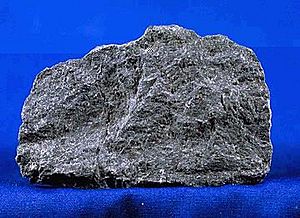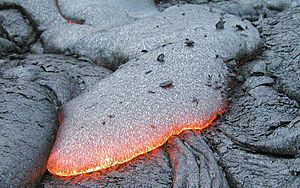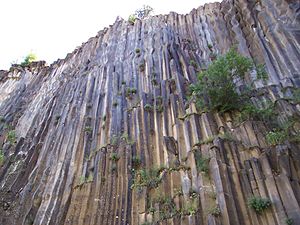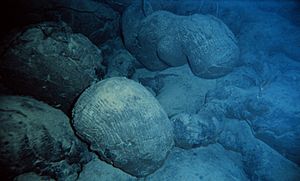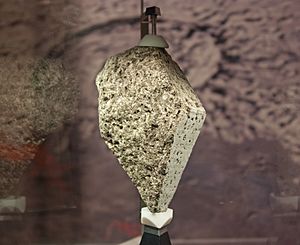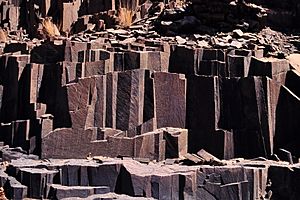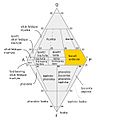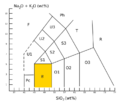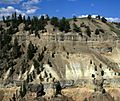Basalt facts for kids
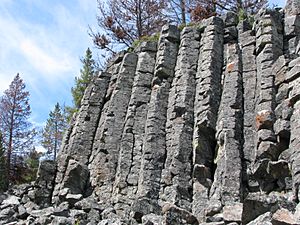
Basalt is a common type of rock that is usually grey or black. It forms when lava from a volcano cools very quickly on the Earth's surface. Because it cools fast, the crystals inside basalt are tiny, making it a fine-grained rock.
When it's new, basalt is black or grey. People often use strong basalt blocks to build roads and sidewalks because it lasts a very long time.
Most basalt on Earth forms when rock deep inside the planet (the mantle) melts. But basalt isn't just on Earth! It's also found on the Moon, Mars, Venus, and even on an asteroid called Vesta. The bottom of the ocean is mostly made of basalt. This happens at places called mid-ocean ridges, where melted rock from the mantle rises up.
Basalt can even be turned into a special fiber. This basalt fiber is sometimes used instead of asbestos, which is a material that can be harmful.
Contents
How Basalt Looks and Forms
The way basalt looks and feels tells us how and where it erupted. For example, was it in the sea, in an explosive eruption, or as slow-moving lava flows like those in Hawaii?
Basalt from Land Eruptions
When basalt erupts into the open air, it forms three main types of lava or volcanic deposits:
- Scoria: This is a lightweight, bubbly rock.
- Ash or cinder: These are small pieces of rock, sometimes called breccia.
- Lava flows: These are rivers of molten rock.
Basalt at the top of lava flows and in cinder cones often has many small holes, making it feel light and "frothy." Basaltic cinders are often red because of iron in the rock that has rusted.
There are two main types of basalt lava flows:
- ʻAʻā: This type of lava is thick and sticky. It forms rough, blocky flows with sharp, broken pieces. You can see these often in Hawaii.
- Pāhoehoe: This lava is very hot and flows easily. It forms smooth, rope-like surfaces. Lava tubes, which are like tunnels for lava, are common with pāhoehoe eruptions.
Explosive basalt eruptions are rare. Basalt is usually too hot and runny to build up enough pressure for a big explosion. But sometimes, lava gets trapped, and gases build up, leading to an explosion. For example, Hawaii's Mauna Loa volcano and Mount Tarawera in New Zealand have had explosive basalt eruptions. Small volcanoes called Maars also form from explosive basalt eruptions.
Sometimes, beautiful crystals of zeolites, quartz, or calcite can be found in the holes (called vesicles) of basalt.
Columnar Basalt
When a thick lava flow cools, it shrinks. This shrinking causes cracks, or joints, to form. If the lava cools quickly, strong shrinking forces build up. Since the lava can't shrink easily sideways, it cracks into columns. These columns often have six sides, like a hexagon, but they can have anywhere from three to twelve or more sides.
The size of the columns depends on how fast the lava cools. Very fast cooling makes tiny columns (less than 1 cm wide), while slow cooling creates large columns.
Basalt from Underwater Eruptions
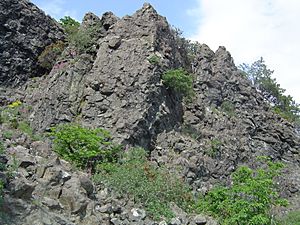
Pillow Basalts
When basalt erupts underwater or flows into the sea, the water quickly cools its surface. This makes the lava form a unique "pillow" shape. Hot lava then breaks through the surface of one pillow to form another. This "pillow" texture is very common in underwater basalt flows. Finding it in old rocks tells us that they formed underwater.
Pillows usually have a fine-grained center and a glassy outer layer. They also have cracks that spread out from the middle. Each pillow can be from 10 cm to several meters in size.
When pāhoehoe lava enters the sea, it usually forms pillow basalts. But when ʻaʻā lava enters the ocean, it can cause small explosions from steam, forming a small cone of rocky debris.
The island of Surtsey in the Atlantic Ocean is a basalt volcano that appeared above the ocean in 1963. At first, its eruption was very explosive because the magma had a lot of water. Later, it changed to a typical pāhoehoe-type eruption.
Sometimes, Volcanic glass can be found, especially on the quickly cooled surfaces of lava flows. This is often seen with underwater eruptions. Pillow basalt can also form from some volcanic eruptions under glaciers.
Life on Basaltic Rocks
Basalt rocks found underwater often show signs of corrosion, which suggests that tiny living things, called microbes, might play a big role in how basalt and seawater interact. Basalt contains a lot of iron and manganese, which can be food for certain bacteria. Some bacteria that eat iron have been found to grow on basalt.
These bacteria have been found on weathered underwater basalts, like those at Loihi Seamount. The way bacteria change the chemicals in basalt and seawater might even help us understand how life began near hydrothermal vents (hot springs on the ocean floor).
Where Basalt is Found
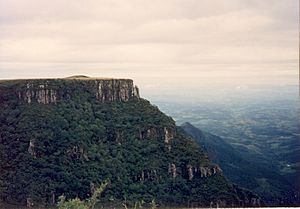
Basalt is one of the most common types of rock on Earth. It makes up almost the entire ocean floor. Above sea level, basalt is common on hotspot islands and near volcanic chains, especially where the crust is thin.
The largest amounts of basalt on land are found in huge areas called continental flood basalts. Some famous examples include:
- The Deccan Traps in India
- The Chilcotin Group in British Columbia, Canada
- The Paraná Traps in Brazil
- The Siberian Traps in Russia
- The Karoo flood basalt province in South Africa
- The Columbia River Plateau in Washington and Oregon
Many groups of islands, like Iceland and Hawaii, are mostly made of basalt because they are located over hotspots where magma rises from deep within the Earth.
Very old basalts, from a time called the Precambrian (billions of years ago), are usually found in mountain ranges. They are often changed by heat and pressure, a process called metamorphism. These changed basalts are known as greenstone belts because they contain green minerals like chlorite.
Basalt on the Moon and Mars
The dark areas you can see on Earth's Moon, called the lunar maria, are huge plains of basaltic lava flows. Scientists have collected these rocks using missions like the American Apollo program and the Russian Luna program. We also find pieces of lunar basalt that fall to Earth as lunar meteorites.
Moon basalts are different from Earth's basalts. They have a lot more iron (about 17% to 22%) and a wide range of titanium. They also show signs of being hit by space rocks, don't have the same kind of rusting as Earth rocks, and have no water in them. Most of the Moon's basalts erupted between 3 and 3.5 billion years ago, but some are as old as 4.2 billion years, and the youngest might be only 1.2 billion years old.
Basalt is also a common rock on the surface of Mars. We know this from data sent back by spacecraft and from Martian meteorites found on Earth.
Changes to Basalt
Metamorphism
Basalts are important rocks in areas where metamorphic changes happen. They can give scientists important clues about the conditions of heat and pressure in these areas.
Metamorphosed basalts are also important because they often contain valuable ore deposits. These include deposits of gold, copper, and other metals.
Uses of Basalt
Basalt is used in many ways:
- Construction: It's used for building blocks and in foundations.
- Roads: Columnar basalt is used to make cobblestones.
- Art: It's used for making statues.
- Insulation: When basalt is heated and pulled into fibers, it creates stone wool, which is an excellent material for thermal insulation. For example, the Code of Hammurabi was carved into a basalt stele over 2.25 meters tall around 1750 BC.
Images for kids
-
Vesicular basalt at Sunset Crater, Arizona. US quarter (24mm) for scale.
-
Columnar basalt flows in Yellowstone National Park, USA
-
Large masses must cool slowly to form a polygonal joint pattern, as here at the Giant's Causeway in Northern Ireland
-
Columns of basalt near Bazaltove, Ukraine
-
Photomicrograph of a thin section of basalt from Bazaltove, Ukraine
-
The Giant's Causeway in Northern Ireland
-
Metamorphosed basalt from an Archean greenstone belt in Michigan, US. The minerals that gave the original basalt its black colour have been metamorphosed into green minerals.
-
The Code of Hammurabi was engraved on a 2.25 m (7 ft 4+1⁄2 in) tall basalt stele in around 1750 BC.
See also
 In Spanish: Basalto para niños
In Spanish: Basalto para niños


